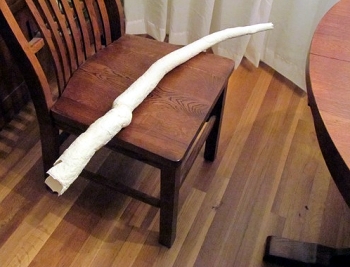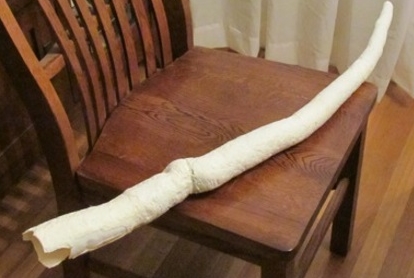|
Identified:
Discussions:
- Indeed it is Kuphus polythalamia (Linné, 1767), and
the year is not 1758, as I wrote to 'Jim', but as Harry stated, 1767
indeed. Back in the nineteen60's, when I was still employed by the
Rotterdam Natural History Museum (Holland), I discovered a complete
specimen of this species in the collection, meaning closed at the
'headside' and showing the two small openings at the 'tailside'. When
shaking the tube 'something' inside rattled, and after making a small
hole close to the 'headside' two almost complete valves and two palettes
could be taken out. These, I suppose, are still available in the Rotterdam
collection.
...Arie J.
-
Vermiculariidae, Serpula polythalamia. Linne' 1767. and the length
was 1185 mm overall. At the small end were two tubelets which I
assumed to be siphons or ??. The shell came to me by mail from an
anonymous donor. ( no return address ) but it was interesting to
note that it came shortly after I had been having some correspondence
from the desk of Dr Ballard at woods hole. The correspondence was
related to his discovery of the fumaroles found at great depth in
the ocean. and their surrounding life forms.
The shell came in four broken sections but the breaks were clean
and glued up with no visible trace. ...
Hope your injuries will heal soon. Don M.
-
Definitely Kuphus polypthalmus, a calcareous tube made by a clam
related to shipworms (Family Teredidae). Found in the Philippines
(labels often say Cebu, but probably from elsewhere in the islands).
Very nice length: they do get to about 200 cm but the ones I've
seen for sale recently are more on the range of 70-80 cm. ... Batt
R.
- Mystery shell no. 1 is Kuphus polythalamia (Linné, 1767:
1266; sp. 803). See < http://www.jaxshells.org/xray.htm>.
... Harry L.
-
There is ample reason for the confusion of these two dates in this
case:
The genus Serpula was introduced by in his Vermes Testacea by Linnaeus
(1758: 786; Genus 298) to accommodate animals which constructed a
calcareous tubular shell. It has become apparent that this was polyphyletic
taxon composed of gastropods (Vermetidae), pelecypods (Clavagellidae
and Teredinidae), and tubicolous annelids. Workers seemed to be divided
in their treatment of Serpula (annelid vs. mollusk) for many years.
Finally, the nominal taxon was assigned to the Annelida by Heppell
(1963) [ICZN (1966)], who designated Serpula vermicularis Linnaeus,
1767 as its type species. Since Serpula is the type genus of Serpulidae
Johnston, 1865, the implications of this action are rather extensive.
Of the 17 species of Serpula introduced by the author (Linnaeus,
1758: 786-788; spp. 690-703; Linné, 1767: 1264-167; spp.
791-806), S. arenaria (Linnaeus, 1758: 787; sp. 699) and S. polythalamia
(Linné, 1767: 1266; sp. 803), are relevant to the problem
at hand. Linnaeus gave three indications for Serpula arenaria: Buonanni
(1864: pl. 20 fig. C), Rumph (1705, 1741: pl. 41 fig. E Solen arenarius;
see also Beekman, 1999: 175), and Gualtieri (1742: pl. 10, figs
L and N). As pointed out by Hanley (1855: 447-448), the co-opting
of the species epithet notwithstanding, the Rumph figure can be
removed from consideration as it is the only indication for Serpula
polythalamia Linné, 1767. There has been general consensus
(e.g., Keen, 1971) on the identity of the latter Linnaean taxon
[Pelecypoda: Teredinidae: Kuphus Guettard (1770: 139-143; pl. 69,
fig. 8)], of which it is the type species (SD Gray, 1847: 188).
Nonetheless, Zammit Maempel (1993: 159) argued that Kuphus arenarius
(Linnaeus, 1758) is the valid name for the this biologic taxon,
stating "Linné (1758, p. 787, paragraph 699) - perhaps
considering Kuphus to be a serpulid - referred to the animal as
Serpula arenaria, a name which he subsequently (1767, p. 1266) changed
to Serpula polythalamia. In 1770, Guettard introduced the genus
Kuphus for the worm-like mollusc Solen arenarius of Rumphius, and
Kuphus polythalamia became the entrenched name for the living species.
However, according to the ICZN rules, the 1758 name is valid despite
Linné's own correction in 1767. Hence the animal should be
referred to as Kuphus polythalamia (Linné, 1758)." My
interpretation of The Code (ICZN, 1999) differs greatly from that
of Zammit Maempel (who, BTW, is from Malta) and I consider Kuphus
arenarius (Linnaeus, 1758) of authors to be an incorrect generic
assignment.
A second cloud surrounding Serpula arenaria Linnaeus, 1758 is its
taxonomic placement at the phylum (Mollusca:Vermetidae vs. Annelida:Polychaeta),
generic, and specific level. The two Linnaean indications (Buonanni
and Gualtieri) are similar and appear more consistent with a large
vermetid than a tubicolous annelid. Of further relevance is the
fact that these two citations were listed, among others, as representing
Vermetus gigas Bivona Bernardi (1832b: 5; pl. 2 figs. 1, 2) in its
original description. In his discussion of V. gigas, Philippi (1836:
170; pl. 19, figs. 18, 18a), also cited these two pre-Linnaean indications
along with Linné (1764: 700; sp. 432) and "Serpula arenaria
L. Gm. 3743," which latter two entities are nothing more than
S. arenaria Linnaeus, 1758, the later one including an expanded
discussion and additional figures. Among other early authors, Hanley
(1855: 447) considered S. arenaria to be a vermetid and wrote: "a
specimen of it is still preserved in the cabinet of Linnaeus (who
has recorded his possession of an example of arenaria)." Kathie
Way (pers. comm., 7 Sept., 2009): "In a Linnaean tin box containing
a variety of unmarked vermetid tubes is one which matches specimens
labelled 'Vermetus gigas Bivona, Marseille' in the B.M.Coll. It
is unmarked, but Linné has placed a dash by the number of
the species in his annot. Ed.12 Syst. Nat. indicating that he possessed
the species." Although this revelation does not tie that or
any other specimen(s) to the original description, it nonetheless
further militates against placement of S. arenaria in the Annelida.
Recently Smriglio [1997: 152-153; species 640 a,b, 641, 642 as Serpulorbis
arenaria (Linné, 1767); more properly: Serpulorbis arenarius
(Linnaeus, 1758)] applied the Linnean name to a large Mediterranean
vermetid. Although the format of this work precluded a chresonymy,
this taxon is clearly synonymous with the species often referred
to Vermetus gigas Bivona Bernardi, 1832b as first noted in the early
Nineteenth Century (vide supra). Smriglio's interpretation also
follows Gray (1847: 156), Cossmann (1912: 138), and Keen (1961:
190), all of who designated the Linnaean taxon a senior synonym
of the type species of Serpulorbis Sassi (1827: 482; Serpulorbis
polyphragma Sassi, 1827 by monotypy). Thus the weight of evidence
supports the following placement of Serpula arenaria Linnaeus: Mollusca:
Vermetidae: Serpulorbis with Serpulorbis polyphragma Sassi, 1827
and Vermetus gigas Bivona Bernardi, 1832 as junior synonyms.
No room for biblio, Harry L.
|

